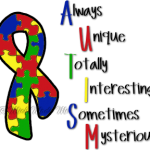Autism and Myotonic Dystrophy
 What Is Autism?
What Is Autism?
Autism or autistic spectrum disorder (ASD) is a behavioral diagnosis. The range of symptoms in autism vary and are generally characterized by an impaired ability to communicate and interact socially with other people. Sometimes children will not meet the diagnostic criteria for autism but will have “autistic-like features.”
The diagnosis of autism is usually made by a developmental or general pediatrician, neurologist, psychologist, psychiatrist, or other specialist. The diagnosis is made after evaluating the child using a number of different behavioral tools and tests. There is no blood test for autism, and imaging studies such as MRIs don’t diagnose the condition; it is purely a behavioral diagnosis similar to ADHD, ADD, etc.
What Causes Autism?
Autism is caused by a number of different factors, some genetic and some non genetic. Much remains unknown about the condition—including what causes it in many individual cases. When a child is diagnosed with autism, blood tests are often ordered rule out the known genetic causes. Childhood Myotonic Dystrophy is one of the most common known genetic (“single gene”) cause of autism. Other genetic causes include deletions of chromosome 15q, tuberous sclerosis, PKU, Fragile X and other rare genetic conditions.
Many times a child with autism will be tested or evaluated for all the known genetic causes of autism but no cause will be found. However, family studies have shown that in families with one child with autism there is an increased risk for another child to have the condition. This risk is not as high as in those families with an identified single gene cause, such as Myotonic Dystrophy, DM1. It is more in line with “multifactorial” risks, similar to heart defects or cleft lip. This leads experts to believe there is a genetic component even in those without a “single gene” identified cause.
Many researchers are trying to determine both the genetic and non-genetic factors that contribute to autism.
Relationship Between Autism and Myotonic Dystrophy
Whereas autism is a behavioral diagnosis, Myotonic Dystrophy is a medical or more accurately, a genetic diagnosis. When associated with Childhood Myotonic Dystrophy, the autism is caused by the genetic change or mutation in the Chromosome 19, which causes the cell to become clogged with proteins causing “Foci” to form. If a child is diagnosed with autism and then diagnosed with Childhood DM1, he or she still has autism, it is just that the cause of their autism is known. It is no different than someone with DM1 also having ADHD or any other behavioral symptom of DM1.
Myotonic Dystrophy (DM1) causes an array of issues in Childhood Myotonic Dystrophy such as learning disabilities, encopresis, early respiratory distress and many others. At puberty the children begin to form the adult form of the disease.
How Many Children With DM1 Have Autism?
Many studies have evaluated the DM1-autism link over the past decade. These studies have shown the percentage of children with DM1 who have autism varying from 50-70% percent. This range may be due to the fact that the diagnostic criteria for autism have varied and the diagnostic tools used have changed.
Since many children with DM1 are interested in social interactions, they may not meet the diagnostic criteria for autism, even as they exhibit autistic-like features such as poor eye contact, shyness, social anxiety, hand-flapping and sensory issues. Autism is much more common in boys with DM1 than in girls with DM1
How Many Children With Autism Have DM1?
Right now not enough studies have been done to determine how many children with autism have DM1
Autism’s Effect on Children With FXS
Studies show that individuals with DM1 who have autism can have a more significant intellectual disability (lower IQ) than those with DM1 who do not have autism.

